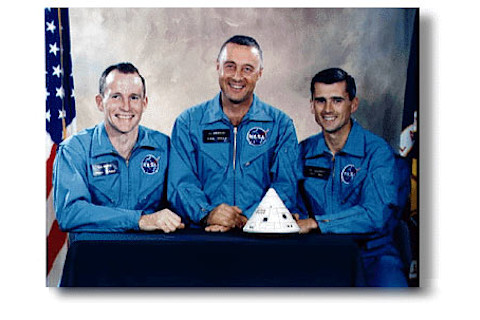
On January 27, 1967 -- 40 years ago today -- a fire swept through the Apollo 1 capsule during a test, killing all three astronauts. Ed White, Roger Chaffee, and Gus Grissom didn't have a chance. 17 seconds after the first yell of "fire!", they were dead. A series of events and circumstances lead to the fire. Perhaps the most famous is the pure oxygen atmosphere used in the capsule during the test. Why did NASA do that? The capsule was designed to use a pure O2 atmosphere while in space. Our air on Earth is a mix of nitrogen and oxygen, but this is difficult to use in space. The capsule needed to be as lightweight as possible (to save on fuel), so using a lower cabin pressure (5 pounds/square inch instead of 15 as on the surface of the Earth) means less weight, and less need for structural strength in the capsule. However, at lower pressure nitrogen can form bubbles in the blood, causing the condition known as "the bends", which can be crippling or fatal. So, at lower cabin pressure, there cannot be nitrogen in the air. Another gas could be substituted (like helium, which does not bubble in the blood) but that only works at higher pressure. The air has to have a certain amount of oxygen in it for the human body to survive, and at lower pressure that means essentially 100% of the air must be O2. The danger of a fire is very real in space, but the lower pressure and lack of gravity (which means no convection; hot air cannot rise) makes a fire danger with pure O2 in space is no worse than it is on Earth with our air. But that means the equipment on board that supplies the air can only handle pure oxygen, which in turn means that on the ground they needed to test with pure oxygen. The big difference is, on the ground the pressure is Earth-normal: 15 psi. At this pressure, fire danger is much higher. A spark is what caused the fire. In the pure O2, it swept rapidly through the capsule. The hatch in the capsule that led outside was designed to open inward, to prevent it from being blown accidentally (which had happened in a real flight in 1961-- ironically, Grissom's Liberty Bell Mercury flight). It had a complicated set of procedures to open, and the astronauts couldn't get it unlatched in time. And so they died. But I'll take this opportunity to make a point. People die. When they push back frontiers, when they explore, when they stand on the vanguard of what is known and what isn't, the chances of catastrophe are higher. The best we can do is try as hard as we can to minimize those risks. Of course, the way to make risks absolutely minimized is to go nowhere, do nothing. That is unacceptable. Ships are safest in the harbor, but that's not what ships are for. NASA, along with a handful of agencies for other countries, want to go back to the Moon. I stand behind this decision. At some point, in some way, we will lose more people. This is inevitable, but it does not mean we should not go. So remember the names of Grissom, White, Chaffee... ... and Komarov... ... and Dobrovolski, Patsayev, Volkov... ... and Scobee, Smith, McAuliffe, Onizuka, Resnick, McNair, Jarvis... ... and Brown, Husband, Clark, Chawla, Anderson, McCool, Ramon ... This list will not end. But there are billions of us, billions, whose names are not on this list, yet our lives have been changed forever due to the ones who are. Per ardua ad astra.













